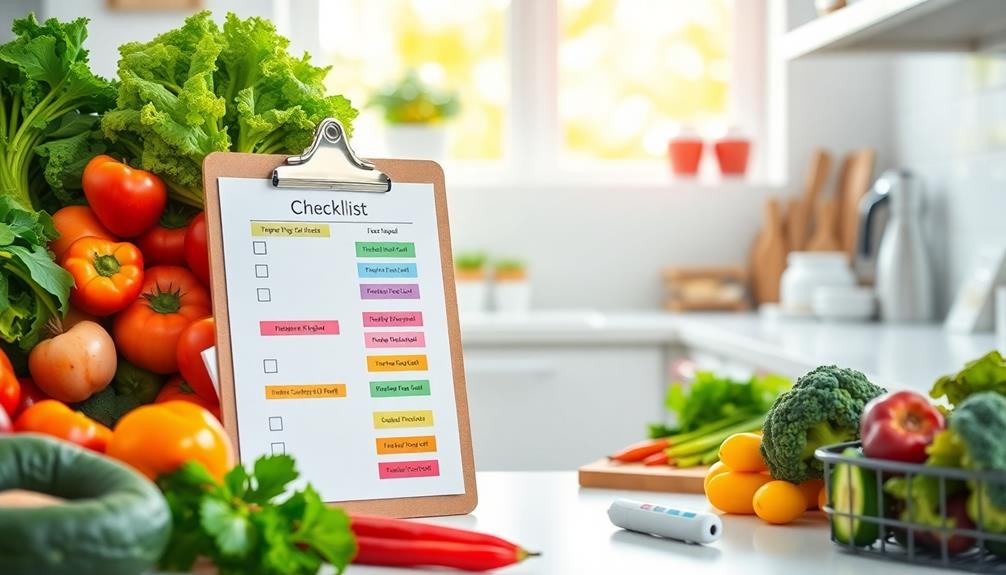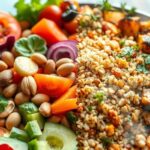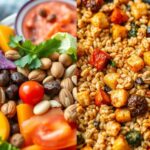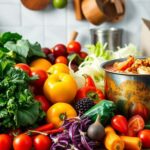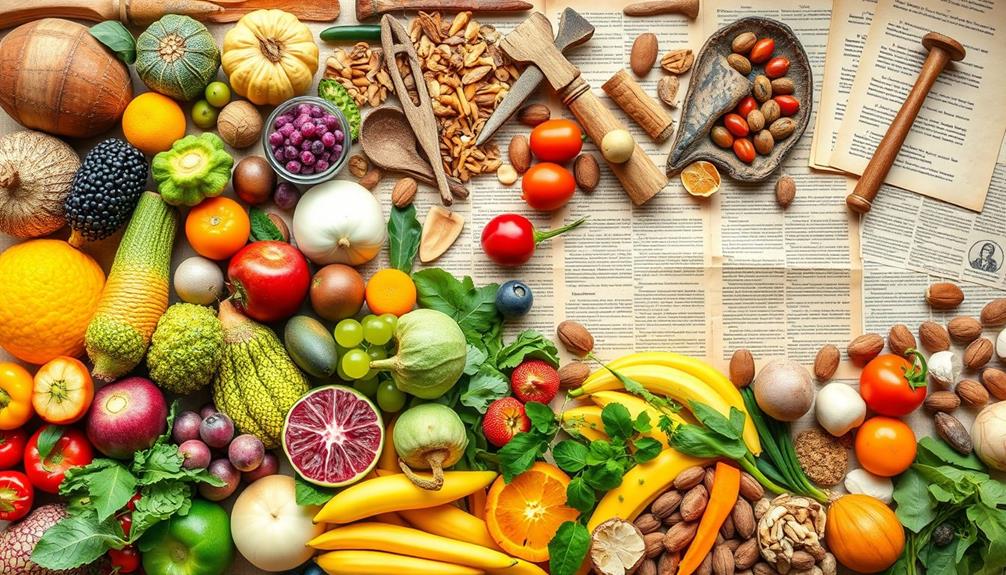The debate over raw versus cooked food centers on their unique benefits. Raw foods often retain higher levels of certain nutrients and enzymes, offering antioxidant-rich options. However, cooking enhances nutrient absorption and deactivates harmful bacteria and anti-nutrients, improving overall safety. Techniques like steaming can help preserve key vitamins while still making nutrients more accessible. A diet that balances both raw and cooked foods can provide essential nutrients and reduce the risk of deficiencies. Understanding these aspects can help you make informed choices about your meals; let's explore more about this intriguing topic together.
Key Takeaways
- Cooking enhances nutrient absorption and bioavailability, particularly for lycopene in tomatoes and beta-carotene in carrots.
- Raw foods retain higher levels of certain vitamins and antioxidants, beneficial for overall health.
- Cooking improves food safety by killing harmful bacteria and deactivating anti-nutrients in grains and legumes.
- A balanced diet incorporating both raw and cooked foods promotes better digestion and nutrient diversity.
- Strict raw diets may lead to potential nutrient deficiencies, highlighting the importance of moderation and variety.
Nutritional Benefits of Cooking
Cooking offers several nutritional benefits that can enhance your overall health. When you cook foods, you increase the bioavailability of certain nutrients. For instance, cooking tomatoes boosts lycopene absorption, and carrots become richer in beta-carotene. These nutrients are linked to lower risks of chronic diseases, making cooked foods a smart choice for your diet.
Additionally, proper cooking can align with your budgeting goals by allowing you to maximize the nutritional value of your meals without overspending on less nutritious options.
Using proper cooking methods, like steaming or stir-frying, helps preserve more nutrients compared to boiling, which often leads to a considerable loss of water-soluble vitamins like vitamin C and B vitamins. The cooking process also breaks down fibers, making it easier for your body to digest and absorb essential nutrients, especially if you have digestive issues.
Moreover, cooking deactivates anti-nutrients found in grains and legumes, enhancing their digestibility and overall nutritional intake.
It's also essential for food safety—cooking kills harmful bacteria that can be present in raw foods, greatly reducing the risk of foodborne illnesses.
Advantages of Raw Foods

When you choose raw foods, you're tapping into a wealth of nutrients and enzymes that cooking can diminish. Opting for a raw diet can greatly enhance your health in several ways: Raw foods are often rich in antioxidants, and their consumption can positively impact overall health, as seen with options like cranberry juice consumption.
- Higher Nutrient Retention: Raw foods like broccoli retain more nutrients, such as sulforaphane, which is three times more abundant when uncooked.
- Enhanced Vitamin C: Foods like red bell peppers provide vitamin C in greater amounts when consumed raw, promoting immune health and skin liveliness.
- Anti-Cancer Properties: Raw garlic preserves its sulfur compounds linked to anti-cancer properties, making it a powerful addition to your meals in its unheated state.
- Improved Bioavailability: Including fermented raw foods boosts nutrient bioavailability and introduces beneficial probiotics for gut health.
Safety and Health Risks

When it comes to safety, raw foods can pose significant risks due to harmful pathogens like E. coli and Salmonella.
Proper diet and food handling are essential for minimizing these risks, as seen in the ultimate hamster care guide which emphasizes the importance of fresh and safe food options.
Cooking your food effectively kills these bacteria, making it a safer option for you and your family.
While raw fruits and veggies can be healthy, it's vital to take into account the potential dangers of contaminated produce.
Pathogen Risks in Raw
Many people underestimate the pathogen risks associated with raw foods, which can lead to serious health issues. The raw food diet may seem appealing, but it comes with a significant risk of foodborne illnesses. Harmful pathogens like E. coli, Salmonella, and Listeria can thrive in raw meat, fish, and poultry, making cooking food an essential step in ensuring your safety.
Here are some key points to think about:
- Contaminated raw vegetables like spinach, lettuce, and sprouts can harbor dangerous bacteria, so proper washing is essential. Additionally, those pondering a raw food diet should be aware of potential cold medications interactions that could arise from dietary changes.
- The CDC estimates that 1 in 6 Americans get sick from foodborne illnesses each year, highlighting the widespread risk.
- Vulnerable populations, such as children and the elderly, face a higher risk of exposure to these pathogens.
- Raw food diets may also expose you to toxins found in certain uncooked foods, emphasizing the need for food safety knowledge.
To enjoy the benefits of raw foods while minimizing risks, always prioritize safe preparation methods.
Cooking for Safety
Cooking is essential for ensuring food safety and protecting your health. It greatly reduces the risk of foodborne illnesses by killing harmful bacteria like E. coli and Salmonella found in raw meat, fish, and poultry. Many raw foods, including spinach and sprouts, can be contaminated, which underscores the importance of safe food preparation.
Certain raw foods also contain natural toxins that are neutralized through cooking, making it a necessary step for safety. For families with vulnerable members, such as young children or the elderly, cooked meals are often preferred to minimize health risks associated with raw diets.
Here's a quick overview of the benefits of cooking:
| Aspect | Impact of Cooking |
|---|---|
| Bacteria Reduction | Kills harmful bacteria, reducing illnesses |
| Digestibility | Improves protein digestibility |
| Toxin Neutralization | Eliminates natural toxins |
| Safety for Vulnerable | Provides safer options for sensitive groups |
Cooking Methods and Nutrient Retention

Considering the impact of different cooking methods on nutrient retention is essential for anyone aiming to maximize their dietary benefits. Certain techniques can help preserve crucial nutrients, especially when it comes to raw vegetables and heat-sensitive vitamins.
For instance, understanding the mechanics of French press coffee can draw parallels to how different cooking methods affect nutrient retention. Here's what you should know:
- Steaming and Microwaving: These methods are great for preserving water-soluble vitamins, unlike boiling, which can cause a loss of up to 50-60%.
- Blanching: A light cooking technique that minimizes cooking time helps retain nutrients effectively.
- Cooking Tomatoes: When cooked, tomatoes boost the bioavailability of lycopene, an antioxidant known for its health benefits.
- Grains and Legumes: Cooking these foods is essential to reduce their anti-nutrient content, improving digestibility and nutrient absorption.
Be mindful of cooking temperatures and durations. High heat or prolonged cooking can degrade nutrients considerably.
And don't forget, reusing cooking water from boiled vegetables can help you retain those valuable water-soluble vitamins.
Comparing Nutrient Loss in Cooking

When you cook your food, the method you choose can greatly affect how many nutrients stay intact. For instance, boiling might strip away essential vitamins, while steaming or microwaving helps retain more of those nutrients.
Additionally, certain cooking methods can enhance nutrient absorption, making some vitamins more accessible to the body. It's important to contemplate how cooking can enhance the bioavailability of some nutrients while potentially diminishing others.
Nutrient Retention in Cooking
While many people appreciate the taste and texture of cooked vegetables, it's important to recognize that cooking can greatly impact nutrient retention. Different cooking methods can lead to varying levels of nutrient loss, particularly with heat-sensitive vitamins like vitamin C and B vitamins.
For example, boiling vegetables may reduce these nutrients by 50-60%. Additionally, incorporating essential oils for health can provide supportive benefits, such as enhancing nutrient absorption and promoting overall wellness.
To maximize nutrient retention, consider these tips:
- Opt for Steaming: This method preserves more vitamins compared to boiling or frying.
- Minimize Cooking Time: Shorter cooking times correlate with less nutrient loss, so aim to cook vegetables just until tender.
- Choose the Right Techniques: Techniques like microwaving can help retain important nutrients effectively.
- Focus on Bioavailability: Cooking can increase the bioavailability of some nutrients, such as lycopene in tomatoes and beta-carotene in carrots, making them more accessible.
Impact of Cooking Methods
Different cooking methods considerably affect nutrient loss in foods, making it essential to understand their impact on your meals. For instance, boiling vegetables can reduce water-soluble vitamins, like vitamin C and B vitamins, by 50-60%. In contrast, methods like light steaming and stir-frying are more effective for preserving nutrients. If you want to maximize the nutritional value of cooked vegetables, keep cooking times short and use lower temperatures.
Interestingly, cooking can also enhance the bioavailability of certain antioxidants. For example, the lycopene in tomatoes becomes more accessible after cooking, increasing its antioxidant activity. However, overcooking can considerably diminish nutrients, so timing matters.
Additionally, just as individuals with BPD often experience intense emotional responses, certain cooking methods can evoke stronger flavors and textures that may resonate more with your palate.
One practical tip is to reuse boiling water from vegetables in soups or stews. This approach helps retain the lost nutrients, enhancing your meals.
If you're following specific food diets that emphasize raw or cooked foods, consider how these cooking methods will affect the nutrients you consume. By being mindful of how you prepare your meals, you can strike a balance between enjoying cooked vegetables and maximizing their health benefits.
Balancing Raw and Cooked Diets

Balancing your diet with both raw and cooked foods can open up a world of nutritional benefits. By incorporating a variety of raw and cooked options, you can optimize nutrient absorption and support your overall health. Here are four key points to take into account:
1. Maximize Nutritional Benefits: Raw foods like cruciferous vegetables and garlic retain higher levels of certain beneficial compounds, while cooked foods enhance the bioavailability of nutrients like lycopene in tomatoes and beta-carotene in carrots.
Additionally, using essential oils in cooking can enhance flavor and health benefits when incorporated thoughtfully.
2. Diverse Diet: A combination of raw and cooked foods creates a more varied diet, promoting better digestion and nutrient absorption.
Cooking methods like steaming and stir-frying can preserve nutrients effectively.
3. Prevent Deficiencies: A strictly raw food diet might lack essential vitamins and minerals, leading to potential deficiencies.
A balanced intake helps guarantee you get all necessary nutrients.
4. Enhanced Digestibility: Cooking often makes plant-based foods easier to digest, allowing your body to absorb the nutrients more efficiently.
Expert Insights on Food Choices

In today's nutrition landscape, experts agree that making informed food choices is essential for maintaining ideal health. The debate over raw vs cooked foods highlights the need for a balanced diet that incorporates both. Each preparation method offers unique benefits and considerations.
| Aspect | Raw Foods | Cooked Foods |
|---|---|---|
| Nutrient Retention | More enzymes, certain vitamins | Enhanced availability (e.g., lycopene, beta-carotene) |
| Food Safety | Higher risk of foodborne illnesses | Kills harmful bacteria |
| Nutritional Concerns | Possible deficiencies (e.g., vitamin B12, iron) | Generally more balanced nutrient profile |
Nutritional therapists often caution against a strictly raw food diet, as it may lead to deficiencies in essential nutrients. While healthier raw options can be beneficial, cooking certain foods can improve nutrient absorption and overall safety. It's vital to monitor your nutrient levels, especially if you lean toward raw diets. Ultimately, a variety of foods cooked and raw will help you achieve a balanced diet, ensuring you meet your nutritional needs while minimizing health risks.
Recommended Dietary Practices
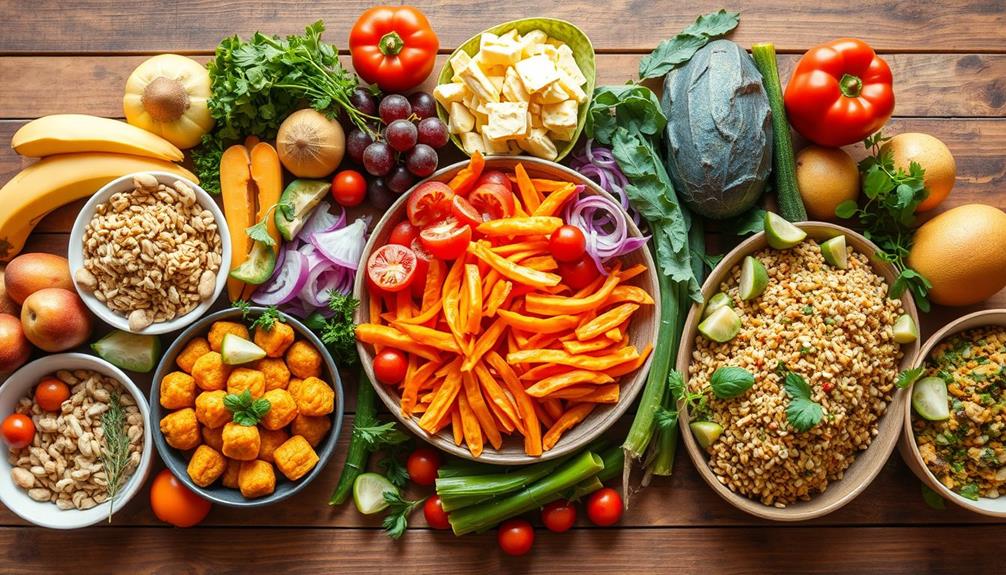
A well-rounded approach to your diet is essential for ideal health. Incorporating both raw and cooked foods can help you absorb a wide range of nutrients effectively.
Additionally, understanding the financial factors for elderly care can guide you in making informed dietary choices that align with your overall wellness goals.
Here are some recommended dietary practices to take into account:
- Mix it Up: Include a variety of raw dog food and cooked dog food in your pet's diet. Certain foods contain more nutrients in their raw state, while others become more nutritious when cooked.
- Cook Wisely: Use cooking methods like steaming or light sautéing to preserve heat-sensitive vitamins, avoiding boiling when possible to reduce nutrient loss.
- Prioritize Food Safety: Cooking greatly enhances food safety by reducing the risk of foodborne illnesses from raw meat, poultry, and fish.
- Watch for Nutrient Deficiencies: If you follow a raw food diet, be mindful of potential nutrient deficiencies, particularly vitamin B12 and iron. Supplementation may be necessary to maintain a balanced diet.
Frequently Asked Questions
Why Is Raw Food Better Than Cooked?
Raw food's often touted for its higher nutrient retention, beneficial enzymes, and potential health advantages. You might find that it improves digestion, enhances skin appearance, and boosts overall wellness by incorporating more fresh fruits and vegetables.
Which Is Healthier Raw or Cooked?
When considering which is healthier, raw or cooked, you should embrace a balanced approach. Some foods offer more nutrients raw, while others provide better benefits when cooked. A varied diet guarantees you get essential nutrients.
Which Food Is Good Raw or Cooked?
Imagine crunching into fresh, vibrant broccoli, bursting with nutrients, versus savoring a warm, rich tomato sauce, full of lycopene. Each food's preparation can enhance or diminish its benefits, so choose wisely based on your nutritional goals.
Is It Better to Eat Meat Raw or Cooked?
When you consider eating meat, cooking it is usually safer. Cooking eliminates harmful bacteria, enhances nutrient absorption, and makes protein more digestible. Enjoy the rich flavors and improved safety that cooked meat offers for your health.
Conclusion
In the grand tapestry of nutrition, both raw and cooked foods weave their own rich threads. While cooking can release flavors and enhance nutrient absorption, raw foods burst with energy and enzymes. Think of your plate as a vibrant palette—mixing the colors of cooked and raw can create a masterpiece for your health. So, don't choose one over the other; embrace the harmony of both to nourish your body and elevate your culinary experience!


